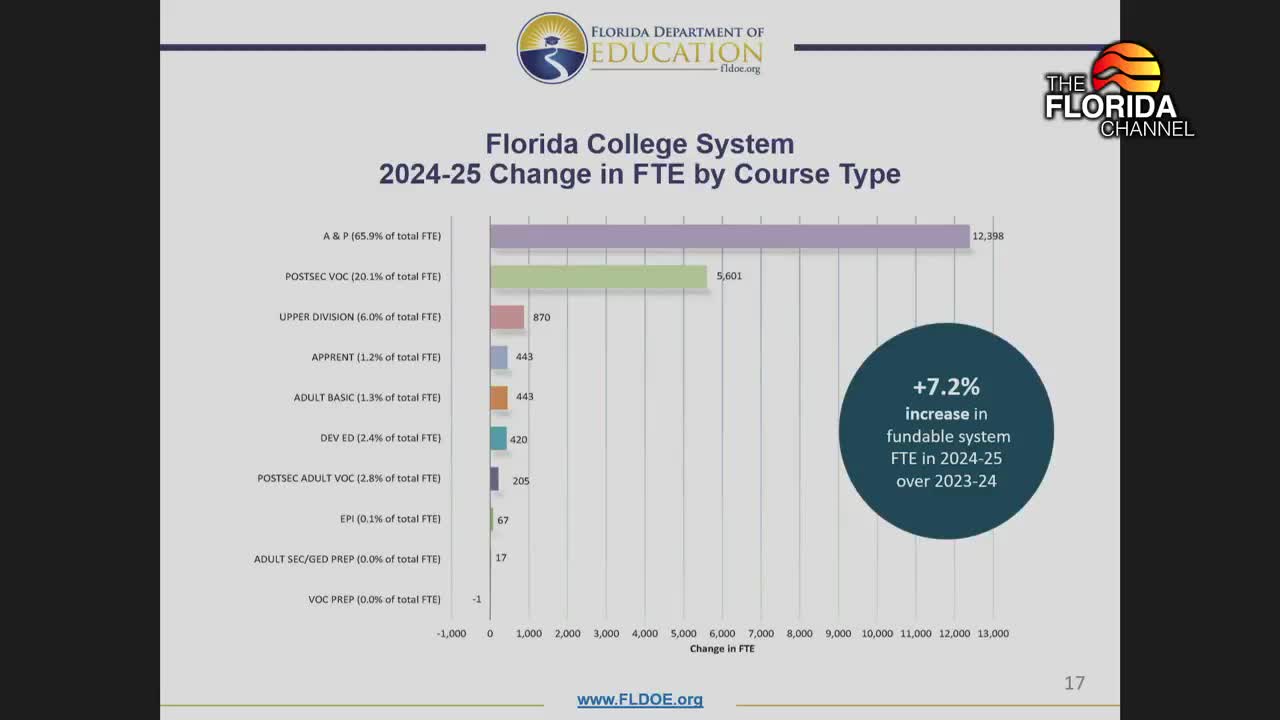South Florida State College says staffing shortfalls force turning away students
October 08, 2025 | 2025 Legislature FL, Florida
This article was created by AI summarizing key points discussed. AI makes mistakes, so for full details and context, please refer to the video of the full meeting. Please report any errors so we can fix them. Report an error »

Fred Hawkins, president of South Florida State College, described staffing and operational constraints at his rural college and urged continued state investment in the Florida College System to sustain local workforce pipelines.
Hawkins told the Senate Higher Education Appropriations Committee that his tri-county service area (Highlands, Hardee and DeSoto counties) covers roughly 2,400 square miles and that the college serves nearly 6,200 students. "The key constraint on expanding program capacity is the ability to attract and retain faculty and staff," Hawkins said, explaining that entry-level faculty salaries at the college start around $47,000 while competing local public-school teacher starting salaries are roughly $50,000 and some private-sector roles pay substantially more.
Why it matters: Hawkins said South Florida State College serves a high share of first-time college students and residents in areas that rank low statewide for high-school graduates going on to higher education. He said limited operational funding has forced the college to turn away students in high-demand workforce programs because it lacks the funds to hire faculty and expand sections; the transcript did not specify the exact number of students turned away.
Program outcomes and local context
Hawkins cited program licensure-pass rates and job placement for several health and allied-health programs at the college: the associate in nursing NCLEX pass rate at the time of the presentation was 92.45% with 100% job placement reported; dental hygiene national board pass rate was 100% with 100% job placement; EMT/paramedic state pass rate was 85% with about 81% job placement; radiography first-attempt pass rate was 74% with 100% job placement.
Hawkins described the college's operational limits as multi-faceted: difficulty recruiting faculty who live locally, competition with K–12 and private-sector salaries, and non-discretionary college expenses such as utilities and facility costs that do not decline when state appropriations tighten. He said the college has constrained tuition and lab fees for many years, limiting revenue options, and asked legislators to consider the Florida College System's return on investment when weighing budget choices.
Follow-up requests
Hawkins offered to provide more localized placement and sector-employment breakdowns by county and requested that the committee consider operational funding that would allow the college to hire additional faculty and expand capacity in key workforce programs. No formal committee action was taken during the hearing; Hawkins' presentation was offered as information for appropriations deliberations.
Hawkins told the Senate Higher Education Appropriations Committee that his tri-county service area (Highlands, Hardee and DeSoto counties) covers roughly 2,400 square miles and that the college serves nearly 6,200 students. "The key constraint on expanding program capacity is the ability to attract and retain faculty and staff," Hawkins said, explaining that entry-level faculty salaries at the college start around $47,000 while competing local public-school teacher starting salaries are roughly $50,000 and some private-sector roles pay substantially more.
Why it matters: Hawkins said South Florida State College serves a high share of first-time college students and residents in areas that rank low statewide for high-school graduates going on to higher education. He said limited operational funding has forced the college to turn away students in high-demand workforce programs because it lacks the funds to hire faculty and expand sections; the transcript did not specify the exact number of students turned away.
Program outcomes and local context
Hawkins cited program licensure-pass rates and job placement for several health and allied-health programs at the college: the associate in nursing NCLEX pass rate at the time of the presentation was 92.45% with 100% job placement reported; dental hygiene national board pass rate was 100% with 100% job placement; EMT/paramedic state pass rate was 85% with about 81% job placement; radiography first-attempt pass rate was 74% with 100% job placement.
Hawkins described the college's operational limits as multi-faceted: difficulty recruiting faculty who live locally, competition with K–12 and private-sector salaries, and non-discretionary college expenses such as utilities and facility costs that do not decline when state appropriations tighten. He said the college has constrained tuition and lab fees for many years, limiting revenue options, and asked legislators to consider the Florida College System's return on investment when weighing budget choices.
Follow-up requests
Hawkins offered to provide more localized placement and sector-employment breakdowns by county and requested that the committee consider operational funding that would allow the college to hire additional faculty and expand capacity in key workforce programs. No formal committee action was taken during the hearing; Hawkins' presentation was offered as information for appropriations deliberations.
View the Full Meeting & All Its Details
This article offers just a summary. Unlock complete video, transcripts, and insights as a Founder Member.
✓
Watch full, unedited meeting videos
✓
Search every word spoken in unlimited transcripts
✓
AI summaries & real-time alerts (all government levels)
✓
Permanent access to expanding government content
30-day money-back guarantee
